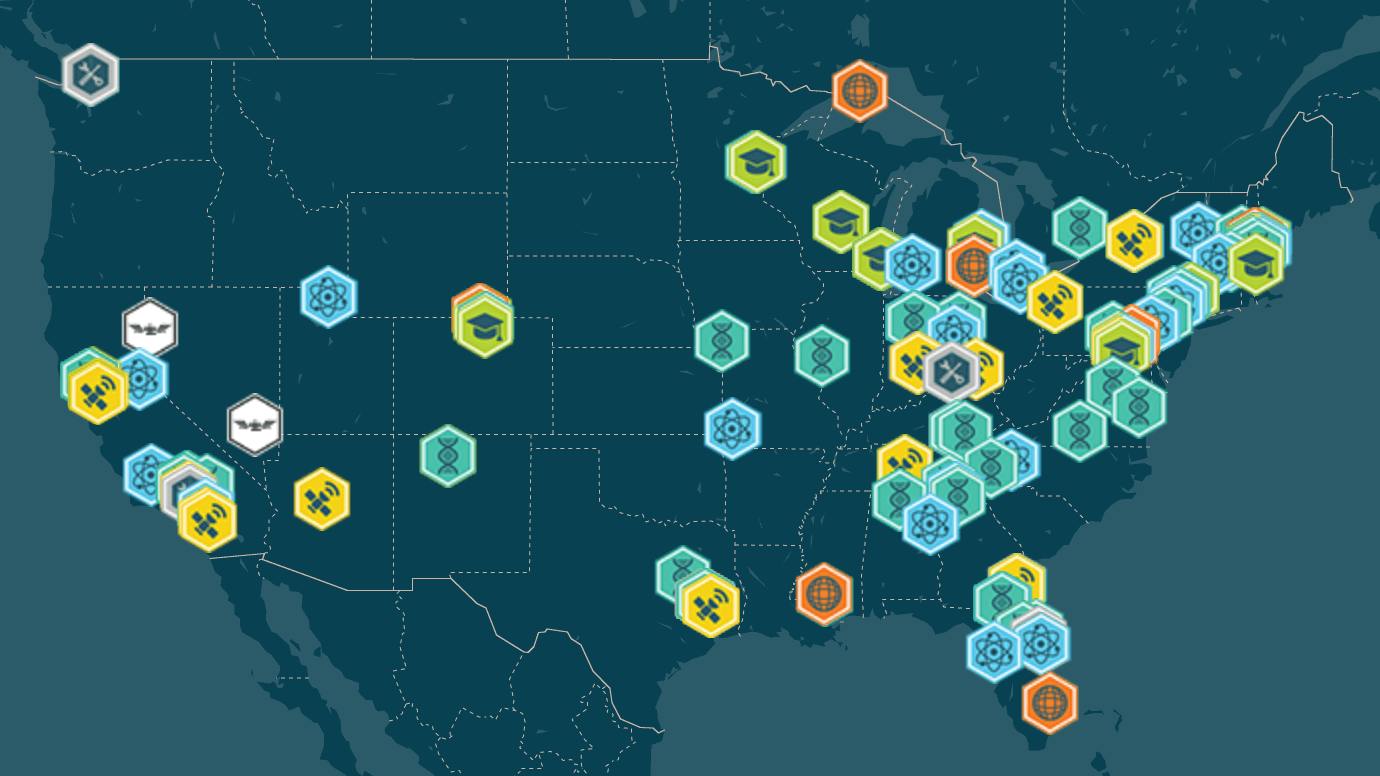At a Glance
- The ISS National Lab selected 62 new R&D projects this year, the most ever and a 24% increase over last fiscal year.
- 64% of new projects are from new-to-space investigators, including large multi-national companies like Bristol Myers Squibb, GlaxoSmithKline, and adidas.
- Returning customers like the National Cancer Institute and Hewlett Packard Enterprise seek to build on past R&D successes onboard the ISS National Lab.
- Approximately one-third of new projects are associated with ISS National Lab Rodent Research Reference Missions, which maximize science return from a traditionally constrained resource.
- 74% of new projects are in the Program areas of Industrialized Biomedicine and Advanced Materials and Manufacturing.
In FY19, the ISS National Lab set several all-time records in our key performance metrics (as defined by our Annual Program Plan with NASA). The ISS National Lab continued cultivating innovative R&D ideas from across the U.S., awarding a record 62 projects and programs, a 24% increase over FY18. Of these new awards, 64% represent new-to-space users—also an all-time record.
Figure 1. Five-year trend in projects and programs selected by the ISS National Lab

Examples of new-to-space awardees and their objectives include the following.
- Bristol Myers Squibb will study protein crystallization kinetics in microgravity to improve drug delivery methods and treatments for diseases such as cancer.
- adidas International, Inc. will observe and measure the stationary (i.e., without physical support) spin of a soccer ball in microgravity to improve the aerodynamic design of the ball.
- GlaxoSmithKline will evaluate protein stability to improve biopharmaceutical drug development and the treatment of human diseases.
- Northwestern University will evaluate fecal samples to better understand the role gastrointestinal microbiota play in overall mammalian health.
- The University of Michigan will investigate mechanotransduction mechanisms of osteoblasts in microgravity to inform research on osteoporosis and age-related diseases on Earth.
- Arizona State University will develop and test predictive models of flow between proteins to better understand hydrodynamics and improve drug development.
- Iowa State University will formulate a novel computational model intended to provide insight on the bone degradation process, toward improving osteoporosis treatment methods.
Returning users, and their follow-on or new initiatives with the ISS National Lab, include the following.
- The University of Minnesota will compare genomic changes in osteoblast cell cultures in orbit, in simulated microgravity, and in normal gravity to determine the mechanisms responsible for accelerated bone loss resulting from skeletal unloading.
- The National Cancer Institute will identify how and when structural changes occur during protein crystallization to better inform cancer therapeutics and drug development.
- The Houston Methodist Research Institute will investigate the effectiveness and safety of an osteoporosis drug to treat bone loss, using a nanofluidic delivery system in a mouse model.
- Hewlett Packard Enterprise will study the performance of a commercial off-the-shelf high-performance computer system over time in the extreme conditions of space.
- Launchpad Medical will study if and how suture skeletal stem cells are affected by microgravity to better understand how bones heal after fracture.
These and other new projects continue to expand the R&D portfolio within the areas of life science, physical science, remote sensing, technology development, and student-participant R&D. Additionally, proof-of-concept and technology demonstrations for new facilities promise to continue expanding options for investigators interested in using the ISS for diverse and cutting-edge R&D. Finally, a growing segment of multi-project programs represent agreements with Implementation Partners who recruit and support discrete R&D projects within in-orbit facilities.
Figure 2. Projects and programs selected by the ISS National Lab
FY19-selected and total to date

The majority of FY19-awarded projects (66%) represent life sciences, including 21 new rodent research projects awarded as part of two research solicitations to support Rodent Research Reference Missions. These reference missions maximize science return from a traditionally constrained resource, allowing tissue sharing among multiple research laboratories. Research using model organisms such as rodents provides insight into not only the effects of spaceflight on astronaut health but also effects that mimic human disease on Earth, such as bone loss, muscle wasting, heart disease, immune dysfunction, and other conditions.
In total, the projects within the ISS National Lab R&D portfolio reflect the multifaceted value proposition of the ISS for advancing terrestrial research questions, and 57% of the all-time portfolio broadly falls within two Program areas formalized in FY19, defined below and described more in Section V.
- Industrialized Biomedicine Program: Projects enabling biomedical advancements with a defined pathway for translation from scientific research to industrial or clinical applications, such as new therapeutics, medical procedures, or diagnostic devices.
- Advanced Materials and Manufacturing Program: Projects that develop next-generation production methods, improve understanding of mechanisms involved in material transformations, advance fundamental materials discovery, or test processes or manufacturing methods of novel design and synthesis pathways.
The ISS National Lab ramped up efforts to attract new investigations within these Programs in FY19, seeking to maximize the opportunity for science return and tangible applications of research results in healthcare and commercial products on Earth. Thus, of the newly awarded projects in FY19, 74% fall within these Programs.
The ISS National Lab also set a record in FY19 with respect to cost-sharing. Operating as a nonprofit with limited funding for awarding research grants, the ISS National Lab continues to innovate new approaches for efficiently and responsibly allocating these taxpayer dollars to promising R&D initiatives in space. In FY19, ISS National Lab funding was matched more than 9.25 times by committed funding from non-NASA, third-party sponsors and the awarded institutions themselves. In fact, 56% of new projects required only ISS National Lab allocation—no grant funding to support their R&D initiatives. More than $190 million in external, non-NASA funds are now committed in support of specific ISS National Lab R&D projects—more than half of which is from commercial entities. Multi-year, multi-project agreements with government and commercial sponsors represent $53 million of these cost-sharing funds (see Appendix A).




